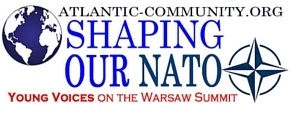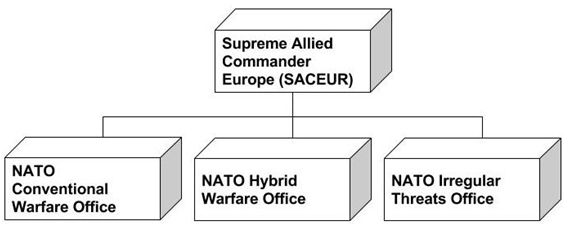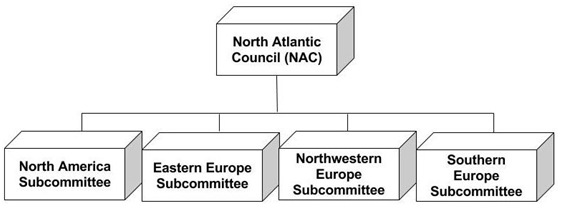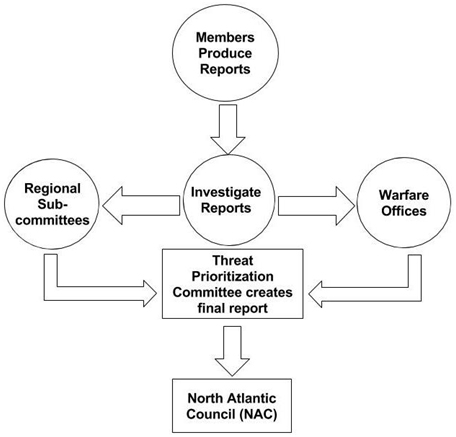Enhancing NATO Cohesion: A Framework for 21st Century Solidarity
Atlantic-Community.org Editorial Team

Memo 52: A diverse set of policies is needed to unify a diverse set of peoples against a diverse set of threats. NATO should reorganize itself, develop a shared clean-energy grid and strengthen links between different national publics.
Unity is NATO's key strength; however, member states often perceive the severity of security risks and threats differently. Thus our project "Shaping our NATO: Young Voices on the Warsaw Summit" has developed policy recommendations for increasing solidarity in the face of divergent threat perception. The next generation of thinkers from across NATO have submitted op-ed in response to the questions:
How can NATO improve cohesion, and strengthen consensus on how to deal with the many different threats? What practical steps can be taken to increase empathy and solidarity between the publics in the NATO Members countries?
We have published the 35 best submissions from 14 different countries and put them up for public debate. Atlantic-community.org members posted more than 200 thoughtful comments. Then ten shortlisted authors have written this joint Atlantic Memo with the best policy recommendations to increase solidarity. Download a PDF copy.
INTRODUCTION
The North Atlantic Treaty Organization is currently faced with security concerns on multiple fronts, which has produced an atmosphere of repeated disagreement within the Alliance. Member countries have different security priorities which need to be addressed, but since the Alliance still possesses precisely the same structure as it did during the Cold War, it is straining to effectively respond to such a wide variety of problems.
A lack of interaction with and between the publics of its members has led many to believe that NATO is not only unconcerned with their problems, but that it has become obsolete. To strengthen the unity of its members, NATO must actively increase solidarity both within the Alliance itself, and between the publics of different member nations. The question of solidarity has both short-term and long-term solutions, both of which must be actively addressed.
To this end, NATO should (1) develop a shared clean-energy grid across the Alliance, (2) reorganize its military and political infrastructures to enable a diversity of responses to its many challenges, and (3) launch education and media campaigns to strengthen links between different national publics, and between those publics and NATO itself. In short, a diverse set of solutions is needed to unify a diverse set of peoples against a diverse set of threats.
POLICY RECOMMENDATIONS
1. Energy Solidarity
1.1. Recommend best practices for energy use within armed forces.
Develop a set of energy use "best practices" for member state militaries, such as energy efficiency, energy type mixture and national fuel sources. NATO should also provide technical advice and financial incentives to adopting these practices. In order to develop these practices, it will be necessary to facilitate knowledge sharing in order to increase energy efficiency and the use of alternative energy sources in military operations. This will build upon the work already being undertaken by the Energy Security Centre of Excellence (ENSEC COE) to enhance interoperability, as well as energy efficiency initiatives within the militaries of member states. Investments to coordinate and share these efforts would be modest and have large potential dividends over the medium term. In addition, this will enhance perceptions of NATO's utility amongst national militaries and governments by making its positive impacts more concrete and long-term, especially for member nations without NATO deployments on their territory.
1.2. Develop an energy security database, involving stakeholders and spurring innovation.
Where feasible, create a database on energy security based on knowledge and methods being utilized by both NATO itself and its various member countries. This database should be accessible to both public and private bodies working within the energy security sphere. A communal database will serve to both better utilize existing knowledge and to enhance perceptions of NATO as an institution within these communities across its constituent stakeholders, establishing solidarity amongst key actors across countries. Access to this database, in addition to standard security screening procedures, will be conditional on commitments to use research and spin off activities generated to enhance energy security amongst NATO members, with the results being jointly owned by the Alliance and the researchers, or other individuals involved. Databases could be developed in concert with existing research initiatives by NATO, as well as via partnerships with other institutional actors such as post-secondary education facilities.
1.3. Prioritize energy risk management in Europe, addressing concerns of eastern members.
NATO must work with institutional partners in eastern Europe, such as the EU and OSCE, to better secure its existing physical energy infrastructure, develop shared energy grids between NATO member countries, and take other measures to lessen dependence on Russian-based energy sources, particularly fossil fuel imports. NATO can facilitate this by expanding the mandate of the ENSEC COE to include cooperation and knowledge transfer between military and civilian authorities for the purposes of facilitating energy security. Modest investment will be required to establish and maintain such formal contacts, which should come from enhancing the ENSEC COE's budget. Energy risk management plans should include agreed-upon response measures to be taken by NATO members collectively should such a situation arise, as well as a plan of action for future relations between NATO and the involved states, both member and nonmember, including Partnership for Peace participants. Such plans will also work to create greater mutual understanding of energy security issues faced by member nations and allow citizens to see tangible benefits of the Alliance on a day-to-day basis.
2. Institutional Changes
2.1 Institute three Warfare Offices to diversify threat response.
NATO's current single force structure is not effective or efficient enough to deal with the myriad of threats facing the Alliance. NATO must consequently reorganize its military into specialized offices in order for the Alliance to more effectively diversify its threat response.
All member countries will automatically be participants in each of these offices. Within each office, there will be staff dedicated to regional areas of operation, which will interact directly with the appropriate regional subcommittees described below. Warfare Offices will be charged with developing military strategy and conducting operations.

Figure 2.1 Structure of Command of Warfare Offices
2.2 Establish regionally focused subcommittees to address multiple problems simultaneously.
In order to not only promote solidarity between different member countries, but to also diversify NATO's ability to handle various problems, regional subcommittees should be created. They will unify the national priorities, work with the Warfare Offices to develop strategy, and acquire resources necessary for the activities and operations carried out in their region. North Atlantic Council's (NAC) unanimous approval will still be required to take military action.
These subcommittees will be organized geographically in order to provide effective responses to the security concerns, which primarily vary by region. Subcommittees will coordinate, not only with the Warfare Offices, but with one another within NATO to preserve the centralized structure.
Membership on a subcommittee is open to all members, but requires a commitment to provide a fair share of the necessary resources required for military operations. The structure of the subcommittees is flexible, since different members can join at any time if they are willing to provide assistance. This allows the states to focus their resources on issues that are of concern to them. It also encourages them to contribute the agreed-upon 2% of GDP on defense. To cope with the constant flux of the geopolitical landscape, each subcommittee will gather at the NATO summit to realign goals and discuss evolving threats and political priorities.

Figure 2.2 Structure of Command of Regional Subcommittees
2.3 Create a Threat Prioritization Committee to consider all members' concerns.
A new Threat Prioritization Committee will take the concerns of every NATO member and produce an objective biannual report to NAC. Their task will be to provide recommendations for the prioritization of threats facing the Alliance. This committee will thereby not have the power to force either NAC or any member countries to take action.
This committee will consist of ten different members. They will not represent any nation, but rather represent the Alliance as a whole. The committee members will be elected during the NATO summit, and be nominated by the individual countries. The member nations are not allowed to nominate a committee member from their own region or country.

Figure 2.3 Process to Create Biannual, Objective Report for NAC
The three Warfare Offices will be funded by NATO's Military Committee, and the activities of the Regional Subcommittees will be covered by their own members. All administrative costs and the independent committee will be funded by the Civil Budget. Acknowledging that bureaucracy can be expensive, the Alliance should absolve any committees or existing structures that will be replaced by the Warfare Offices, Regional Subcommittees, and the Threat Prioritization Committee.
2.4 Reciprocate political and military support in the Pacific.
European NATO states should offer political and diplomatic support to the US in its Asia-Pacific strategy. After a decade of political and diplomatic assistance, contingents of European NATO troops will be deployed on a rotational basis to the Asia-Pacific region. Responsibility for this will fall to the North America Subcommittee.
Though these efforts will possibly require a change in the North Atlantic Treaty, European members of NATO must be willing to show their support for the United States' actions in Asia if they hope for reciprocal action in Europe. A change to the North Atlantic Treaty would greatly benefit NATO in order for members to remain united as Asian nations are quickly gaining power in the geopolitical landscape.
3. Increasing Public Awareness and Perception
3.1 Create a "NATO culture" to educate publics on the importance of the Alliance.
An effective, long-term method of creating deep seated solidarity would be to develop a "NATO culture". Comprehensive education programs, social media campaigns, and historic tours will bring NATO to the citizenry, and share the continued purpose and importance of the Alliance with them. This can be achieved by increased investment in Atlantic Treaty Associations (ATAs), especially their educational and information distribution programs, and other organizations that reach member states' citizens. However, as only a small part of the funding to ATAs comes from the NATO HQ, their work is not always successful. We suggest having a deeper and more active cooperation and to share ideas between the HQ and member states and make reciprocal suggestions. This will make the HQ more aware of situations in member states and allow NATO to better interact with publics.
A significant part of PDD funding and grants currently goes into research projects, which mainly reaches out to those who are already informed but not those who are or will be shaping public opinion. More attention should be paid to educating the general public, particularly the youth. NATO PDD should fund NATO negotiation simulations, "NATO Days", and visits to military bases. These projects already exist in some member countries, however, with added PDD support, these and other projects could be offered in all member countries.
In addition, social media should be used by NATO in cooperation with member countries and ATAs to not only increase awareness of its activities and principles in the wider public, but also to connect the people of different countries with one another. By learning about each other's history, culture, and security concerns, the Alliance will become more united, and the hampering effect of diverging threat perceptions on decision making will decrease.
NATO-sponsored history and memorial tours would also improve public perception of the Alliance and grant new perspectives to those who only currently perceive their own country's point of view. The Alliance should also offer trips for citizens of similar occupations or positions to visit one another in different NATO countries. This would create a meaningful bond between people of different countries, and would connect members of society that may have a strongest influence. During times of trouble, NATO uses civil-military co-operation as a force multiplier. By connecting not only business leaders, local politicians, and academics, but also other occupations NATO will be able to increase support between populations, even in the face of diverging threat perceptions.
3.2 Change the name of the organization to increase sense of community and cohesion.
NATO should adopt a new name, because its current name has become obsolete by both the enlargement of the Alliance and the shift in the nature of the threats it faces, with the Cold War having ended. A new name would benefit the Alliance, and allow it to remain relevant in the twenty-first century.
The new name would not only increase cohesion, as it would be agreed upon by all member countries, but it would increase the sense of community among members. It would also consider the future orientations of the organization, not only in terms of crisis management but how NATO's sphere of action might be broadened. It would take into account the potential integration of new members. Finally, it would need to be perceived as inherently non-aggressive by external organizations and states. This name would also contribute to the development of a NATO whose aim is to integrate each member's national identity in order to maximize cooperation and capabilities within the Alliance.
CONCLUSION
NATO's original purpose of providing a secure military alliance for its members is still crucial in today's geopolitical climate. However, in order to successfully realize this goal, the means of accomplishing NATO's mission must change with the world around it. NATO should consistently seek to improve both itself and its operations with both short- and long-term solutions. Implementing strategies such as a clean energy plan, a reorganization of its military and political structure, and a campaign to improve public perception will ensure that both NATO and its members will not only be able to adapt and survive, but to thrive in peace.
Pierre Dugué is a BA candidate in War Studies at King's College London. He has previously studied History at the Paris Sorbonne University.
Simon Fraser studied Politics and International Relations at Kingston University. Currently, he is studying for a master's degree in International Relations at the University of Exeter.
Ryan Hulec has a degree in Global Interactions from Cleveland State University. He has also welcomed many international visitors to the Northeast Ohio area.
Adéla Jiřičková is a BA candidate in International Relations at the Anglo-American University in Prague. She is also an associate in Association for International Affairs.
Joseph Kelledy is a BS candidate in Astronomy and Physics at the University of Arizona. He is currently involved with research at Steward Observatory on the relationship between dark matter / baryon interaction and the structure of the universe.
Mariita Mattiisen has a Master's degree from the University of Tartu and works in Estonian Atlantic Treaty Association. She has previously worked as a director of the European Movement Estonia and as an analyst in the Estonian Parliament.
Mathilde Skydt Ganderup is a MA candidate in International Development and Relations at Aalborg University and International Officer at Aarhus University. She is also Partner and CCO in a recruitment company in Aarhus.
Youmna Sirgi is a BA candidate in International Affairs at The George Washington University.
Lewis Smart graduated in International Relations from Plymouth University. He has worked on a general election campaign and currently works in London for a public affairs company with a strong interest in aerospace and defense
Carter Vance is an MA candidate in Political Economy at Carleton University and a Junior Research Fellow at the NATO Association of Canada
The authors wish to thank all online commenters for their valuable input: http://www.atlantic-community.org/nato-solidarity
The authors have written this Memo after qualifying with individual submissions, which provide more detailed information on the aforementioned policy recommendations for those interested:
Pierre Dugué: To Enhance Cohesion, NATO Should Change Its Name
Simon Fraser: How Europe and the US can Usher in a New Age of Solidarity
Ryan Hulec: NATO Needs to Make itself Heard
Adéla Jiřičková: Making NATO More Popular for Everyone
Joseph Kelledy: How to Fairly Prioritize the Alliance's Security Threats
Mariita Mattiisen: Social Media Is the Answer to Increasing Solidarity
Mathilde Skydt Ganderup: Making NATO more institutionalized
Youmna Sirgi: A Time Capsule to the Present: Restructure. Recruit. Rebalance.
Lewis Smart: Solidary through Diversity
Carter Vance: Energy Security Strategy Crucial to Checking Russian Aggression
The articles have been written for category D "Increasing Solidarity in the Face of Divergent Threat Perception" of the "Shaping our NATO: Young Voices on the Warsaw Summit" competition and respond to the questions: How can NATO improve cohesion, and strengthen consensus on how to deal with the many different threats? What practical steps can be taken to increase empathy and solidarity between the publics in the NATO Members countries?
The competition has been made possible by generous contributions from the NATO Public Diplomacy Division, the Konrad Adenauer Foundation and the Foundation for Polish-German Cooperation.
